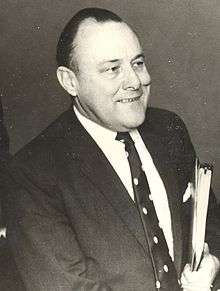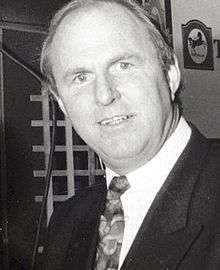Deputy Prime Minister of New Zealand
| Deputy Prime Minister of New Zealand | |
|---|---|
|
| |
|
Her Majesty's Government in New Zealand Department of the Prime Minister and Cabinet | |
| Style | The Honourable |
| Member of | |
| Reports to | Prime Minister of New Zealand |
| Appointer | Governor-General of New Zealand |
| Term length | At Her Majesty's pleasure |
| Formation | 13 November 1954 |
| First holder | Sir Keith Holyoake |
| Salary | $326,697 (NZD)[1] |
| Website | www.beehive.govt.nz |
 |
| This article is part of a series on the politics and government of New Zealand |
| Constitution |
|
|
|
|
Related topics |
The Deputy Prime Minister of New Zealand (Māori: Te Pirimia Tuarua o Aotearoa) is the second-most senior minister in the Government of New Zealand, although this seniority does not necessarily translate into power. The office was created as a ministerial portfolio in 1954. The officeholder usually deputises for the Prime Minister at official functions.
Appointment and duties
Generally, the position is held by the deputy leader of the largest party, but now that the MMP electoral system makes coalitions more likely, the role may instead go to the leader of a junior party. This occurred with Winston Peters, leader of New Zealand First,[2] and Jim Anderton, leader of the Alliance.[3]
The post of Deputy Prime Minister was formally established in 1954; eighteen people have held the position (one of them doing so twice). Of those people, only Holyoake, Marshall, Watt, Muldoon, Palmer, Clark and English have eventually served as Prime Minister.[4]
The duties of the Deputy Prime Minister are to act on behalf of the Prime Minister in his or her absence overseas or on leave. The Deputy Prime Minister has always been a member of the Cabinet, and has always held at least one substantive portfolio. If the Prime Minister were to die, become incapacitated or resign, the Governor-General would normally appoint the Deputy Prime Minister as Prime Minister on an interim basis until the governing party elects a new leader, but is not obligated to do so.
Little scholarly attention has focused on deputy prime ministers in New Zealand or elsewhere. In 2009, an article by Steven Barnes appeared in Political Science where nine 'qualities' of deputy prime ministership were identified: temperament; relationships with their Cabinet and caucus; relationships with their party; popularity with the public; media skills; achievements as Deputy Prime Minister; relationship with the Prime Minister; leadership ambition; and method of succession.[5] Barnes conducted a survey of journalists, academics, and former Members of Parliament to rank New Zealand's Deputy Prime Ministers since 1960. Across the nine deputy prime minister 'qualities', Don McKinnon achieved the number one ranking, followed by Brian Talboys, Michael Cullen, and John Marshall. In a second 'overall' ranking, Cullen was ranked number one, followed by Talboys, McKinnon, and Marshall. Jim Anderton, Winston Peters, and Bob Tizard were ranked lowest in both sections of the survey.[5]
List of Deputy Prime Ministers of New Zealand
| Colour key (for political parties) |
|---|
| No. | Name | Portrait | Term of Office | Prime Minister | |||
|---|---|---|---|---|---|---|---|
| 1 | Keith Holyoake |  |
13 November 1954 | 20 September 1957 | Holland | ||
| 2 | Jack Marshall |  |
20 September 1957 | 12 December 1957 | Holyoake | ||
| 3 | Jerry Skinner |  |
12 December 1957 | 12 December 1960 | Nash | ||
| (2) | Jack Marshall |  |
12 December 1960 | 9 February 1972 | Holyoake | ||
| 4 | Robert Muldoon |  |
9 February 1972 | 8 December 1972 | Marshall | ||
| 5 | Hugh Watt |  |
8 December 1972 | 1 September 1974 | Kirk | ||
| 6 | Bob Tizard |  |
10 September 1974 | 12 December 1975 | Rowling | ||
| 7 | Brian Talboys |  |
12 December 1975 | 4 March 1981 | Muldoon | ||
| 8 | Duncan MacIntyre | .jpg) |
4 March 1981 | 15 March 1984 | |||
| 9 | Jim McLay | .jpg) |
15 March 1984 | 26 July 1984 | |||
| 10 | Geoffrey Palmer |  |
26 July 1984 | 8 August 1989 | Lange | ||
| 11 | Helen Clark |  |
8 August 1989 | 2 November 1990 | Palmer | ||
| Moore | |||||||
| 12 | Don McKinnon | .jpg) |
2 November 1990 | 16 December 1996 | Bolger | ||
| 13 | Winston Peters |  |
16 December 1996 | 14 August 1998 | |||
| Shipley | |||||||
| 14 | Wyatt Creech |  |
14 August 1998 | 5 December 1999 | |||
| 15 | Jim Anderton |  |
5 December 1999 | 15 August 2002 | Clark | ||
| 16 | Michael Cullen |  |
15 August 2002 | 19 November 2008 | |||
| 17 | Bill English |  |
19 November 2008 | 12 December 2016 | Key | ||
| 18 | Paula Bennett |  |
12 December 2016 | Incumbent | English | ||
References
- ↑ "Parliamentary Salaries and Allowances Determination 2016" (PDF). New Zealand Parliament. Retrieved 6 July 2017.
- ↑ "Rt Hon Winston Peters". New Zealand First. Retrieved 6 July 2017.
- ↑ Vernon Small (7 December 2012). "Labour leader looks to outsiders for deputy". Stuff.co.nz. Retrieved 6 July 2017.
- ↑ Note: Some lists consider Hugh Watt as a New Zealand Prime Minister. Watt served as acting Prime Minister for seven days from 31 August to 6 September 1972 following the death of Norman Kirk. He is not normally counted in the official numbering of New Zealand Prime Ministers.
- 1 2 Steven Barnes, 'What About Me? Deputy Prime Ministership in New Zealand', Political Science, Vol. 61, No. 1, 2009, pp. 33-49